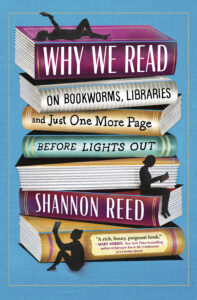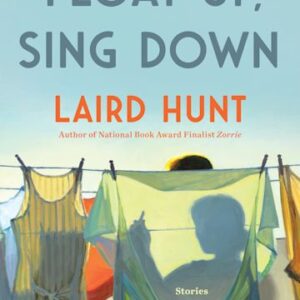Less is More: Shannon Reed on Re-Learning How to Read
“Reading is no longer a race that I might win, but a lifelong companion.”
I dislike our American tendency to blame our beleaguered educational system for our bad reading habits. So I’m glad I can truthfully place the blame for my tendency to read far too fast on my once-favorite dining establishment: Pizza Hut. While I would still gladly go for an extra-cheese personal pan right this minute if you’re buying, it’s indisputably true that Pizza Hut created the BOOK IT! program, and the BOOK IT! program is what messed this reader up—bad.
That’s not to imply that the BOOK IT! initiative hasn’t done a lot of good. According to Mental Floss, more than fourteen million schoolchildren have participated in the program since its inception in 1984. The idea is simple: the more books students report having read, the more prizes they earn, such as stickers, buttons, and certificates, eventually culminating in coupons for free personal pizzas.
It’s infallible logic. Kids should read more. Kids like pizza. If kids read more, we’ll give them free pizza. You can see why Pizza Hut went for it. I mean, free pizza is still the method we use at my university to coax our students to come to events. We also often give them free T-shirts. So does Pizza Hut’s BOOK IT! program.
I learned the art of reading without actually understanding what I’d read.All of this is great, particularly for children who need a little coaxing to keep reading, especially those in families that don’t get to eat out that often, so let me say quite clearly: I have no beef with the Pizza Hut BOOK IT! program. Good work, all around!
However. I was not one of the children who needed to be coaxed. I read, a lot, already: in the bathroom, in the car, in the dentist’s chair, waiting for my dad to pick me and my cello up, at my brother’s soccer games, and while theoretically helping my mom with dinner. I read as we drove through the raw natural beauty of Yosemite National Park and missed seeing several bears. I read during my math classes at school, when I definitely should have been listening. In other words, I did not need to be enticed to read more.
I also did not need to eat more Pizza Hut pizza. This is not a commentary on my health, or on whether anyone should be eating Pizza Hut all that often, but a statement of fact. When I was a child, there was a Pizza Hut a short walk from our house, and it was my absolute favorite place to dine, which led to a weekly scene in our living room. My father wondered aloud to my mother where we should get dinner, and I would race in from three rooms away to suggest Pizza Hut. I didn’t get my way all the time, but it was often enough.
I’m honestly not sure if I’m trying to tell you that the BOOK IT! system was rigged against me, or that I was rigged against it, but anyway, I was deeply motivated and highly adept at pushing the system to its breaking point. I went for it with my whole heart, determined to earn at least one free pizza coupon a marking period. And thus, I learned the art of reading without actually understanding what I’d read.
I’m sure you’re familiar. You have to read a book for some reason, and you’re not that excited about it (see “Because We Had To” earlier), but you’re a good person, you’re not going to say you read a book if you didn’t. So you run your eyes over every single line. And yet, when you get to the end, much more quickly than you should’ve, you’d be hard-pressed to explain even the basics of the book. It has a main character, and that main character had a problem. Maybe? Things happened, and then the problem resolved. Probably.
Most of us have done this when, say, encouraged to read a book on driving safety by our insurance company in order to get a rate reduction, or when given a book self-published by a friend who writes rhyming acrostics about their cat’s nine lives. We open the cover. We scan every paragraph! No page is left unturned! No one can say we did not read the book!
Except, you know, we didn’t really read the book. We saw every page of the book.
I taught myself to “read” this way, in a mad quest to earn pizzas and not have to go to the Jolly Roger, one of my father’s favorite restaurants, which specialized in Cuisine and Decor for the Aged and had the kind of chicken strips I didn’t like. No one ever called me out for not really reading, and I didn’t perceive any problems with this method myself, even as it drifted into my own, less output-oriented leisure reading. While I read some books with great attention—you will soon hear about my love for David Bowie’s Serious Moonlight—I just didn’t grasp that all books can be read with attention. Even the insurance pamphlet, in hindsight, probably has some good tips.
No one intervened. If anything, my method was encouraged. Almost every adult I encountered thought it was great that I read so much, and I continued to get high marks on my papers and tests in English, so bully for me, it seemed. In high school, as I “read” the assigned books, like Heart of Darkness, I continued to faithfully run my eyes over each page. It never occurred to me that slowing down might help me comprehend them, most likely because I resented having to read them at all.
I was no longer earning pizzas but still somehow believed that adding to my growing stack of books marked Read mattered more than what I got from the experience of reading them. No wonder I have trouble recollecting much about the thousands of books I read during my teen years. Those books had main characters, with problems… and that’s about all I can remember.
It wasn’t until I got to graduate school at NYU that the BOOK IT! method finally petered out for me, and thank goodness. One required class, Dramatic Criticism, was heavy on theory, heavy on reading, heavy on reading about theory. But hey, everyone knew I was a reader, that was my thing. No problem.
Alas. I was miserably lost on the tests for that class. We were given lengthy quotes and asked to locate them from our (hundreds of pages) of reading and then to explain them. I could barely do this. It’s apparent to me now (and you, I’m sure) why this was: I hadn’t actually read the books these quotes were taken from. I had looked at them, every page. But I had, at best, skimmed them, as if the end result was going to be a pizza coupon, not a test.
I realized that I had to slow down, to read less in order to understand more.I passed the class (and, God help me, the also-required Dramatic Criticism II), but what I really learned was that I was not nearly the reader I had thought I was. What followed wasn’t exactly a long, dark night of the soul but more of a thoughtful amble of the mid-afternoon. If reading was my thing, I thought, as I wandered through Washington Square Park, another B− test in hand, and if I wasn’t a particularly good reader… Well. Huh. I thought about the thousands of books I had read and couldn’t remember much about. Was that who I wanted to be? How many personal-pan pizzas can one person eat, anyway?
I realized that I had to slow down, to read less in order to understand more. It wasn’t easy to learn to do this. The best technique I came up with was to ask myself as I came to the end of each page if I remembered what I had just read. Not every detail, of course, but perhaps what century the book was set in? If the main characters were aliens or not? That helped. Also, I started reading most books the way I read my coursework—with a pencil in hand, making notes if I could. I began to keep journals of my reading, and, when they became available, tracked it on apps, not (only) to keep a log of how much I read, but of what I read, of what I’m putting into my brain. This wasn’t easy, and I still struggle with it. I’m a good reader, y’all, but I am an excellent skimmer.
Luckily for me, my subsequent career as a professor encouraged me to slow down even more. High-school students hope you miss some of their typos and nearing-deadline gibberish as you read their words, but college creative writing students do not like it if your critique of their story fails to grasp its basic premise because you skimmed it. They want your complete attention on their work, and they will absolutely tell you if they feel they haven’t received it. Besides, they will write better, hugely better, if they feel someone is paying attention, so I was, and am, very motivated to read closely.
Some of those very same creative writing students have mentioned the Pizza Hut BOOK IT! program from their own childhoods, and I’m pleased to report that their stories vary. Some, like me, still can’t believe they got rewarded for running a long con. Others didn’t like Pizza Hut. And some did read more because they wanted the stickers, the buttons, the T-shirt, and the pizza. So, well done, Pizza Hut! What began with you pushing your product has led some of your recipients to pursue degrees in English and a lifetime of reading.
Sometimes I miss my skim-like-the-wind days. I would give anything to be back at the Jolly Roger with my dad, bored and sneaking peeks at the book in my lap. I know that the next time I tour through Yosemite, I’ll be the one driving, so no reading will occur. And I would really, truly love if someone would give me a free pizza for reading. Or a cookie.
A glass of water? Or a Netflix deal to adapt this book into a long-running series? Thanks.
And yet, for all my nostalgia, I like the way I read now. There are stacks of books in my house that will never be depleted, not just because I’m constantly adding to them—true—but because I simply can’t get to them all, not in this lifetime, not at the slower, more attentive pace at which I now read. Reading is no longer a race that I might win, but a lifelong companion, a dear friend who’s always there for me but never, ever asks for a slice.
__________________________________

Excerpted from Why We Read: On Bookworms, Libraries, and Just One More Page Before Lights Out by Shannon Reed. Copyright © 2024. Used with permission from Hanover Square Press, an imprint of HarperCollins Publishers.




















